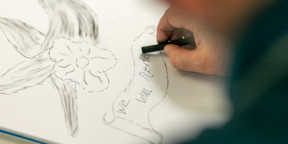Guided Art Appreciation
Guided Art Appreciation
Looking at art engages our intellect, our emotions, our senses, and our imagination. It can reduce stress, improve brain functioning, and help us to refresh.
As well as being a subject of general interest, art appreciation has long been associated with improving mental and physical health.
The below are just a few examples of this:
- Nursing pioneer Florence Nightingale wrote about the benefits of colour, light and form in the healing of body and mind and promoted the display of artwork near hospital beds to aid recuperation.
- During the Second World War, the British Red Cross Picture Library loaned artwork to hospitals and gave lectures about the artwork to help the war wounded along the road to recovery.
- Findings from studies into the science behind art appreciation, for example by University College London and the University of Toronto, show that when we look at beautiful art, it can normalise heart rate, blood pressure and cortisol level.
- MRI scans on people viewing art have shown activation of the brain’s instinctive pleasure and reward systems and areas involved in processing emotion.
- Neuroscientists at University of Toronto have shown that the brain’s default-mode network becomes engaged when art-viewing. This is involved in daydreaming and memory retrieval, so this means that people are processing at a deeper level.
Pleasure is gained not only from the attractiveness of the artwork but also from deriving meaning and understanding. Different functions of the brain are involved at the same time, resulting in a powerful experience. If some context is given to the image, such as the artist’s intention or history, it's more likely to be enjoyed.
At this challenging time, we invite you to set aside 10-minutes each day to experience your own art appreciation and help stimulate your brain and emotions.
Below are five simple steps to help you do this:
- Look at a piece of artwork that you find interesting. It might be the colours, the light effects, or subject matter – whatever catches your eye.
- To gain maximum positive benefits, try not to select something that has any negative associations, which might to stir-up difficult memories.
- Find a comfortable space where you won’t be interrupted, relax, and immerse yourself in the image. Notice the colours, shapes and lines.
- Imagine being in that peaceful place or refreshing environment. Conjure up the fragrant smells and gentle sounds – whatever is relevant to your chosen image.
- When it’s time for you to get on with something else, don’t rush. Gradually notice your breathing; notice the room around you; maybe have a stretch; then get on with your day.
To help you make a start, we’re sharing recordings of narrated art appreciation, which will guide you and which you may find useful.
The Harvesters
By Pieter Bruegel the Elder
Guided by our Art Therapist, Jan, explore and take in 'The Harvesters' created by Pieter Bruegel the Elder.
Once completed, come out of your space slowly, breathing and taking in the sights, sounds and smells around you.
Salisbury Cathedral
By John Constable
Guided by our At Therapist, Jan, explore and take in 'Salisbury Cathedral from the Meadows' created by John Constable.
Once completed, come out of your space slowly, breathing and taking in the sights, sounds and smells around you.
Exotic Landscape
By Henri Rousseau
Guided by our At Therapist, Jan, explore and take in 'Exotic Landscape' created by Henri Rousseau.
Once completed, come out of your space slowly, breathing and taking in the sights, sounds and smells around you.
A Table of Desserts
By Jan Davidsz. de Heem
Guided by our At Therapist, Jan, explore and take in 'A Table of Desserts' created by Jan Davidsz. de Heem.
Once completed, come out of your space slowly, breathing and taking in the sights, sounds and smells around you.
Three Forms
By Dame Barbara Hepworth
Guided by our At Therapist, Jan, explore and take in the 'Three Forms' created by Dame Barbara Hepworth.
Once completed, come out of your space slowly, breathing and taking in the sights, sounds and smells around you.
The Seine at Asnieres
by Renoir
Guided by our At Therapist, Jan, explore and take in 'The Seine at Asnieres' created by Renoir.
Once completed, come out of your space slowly, breathing and taking in the sights, sounds and smells around you.
Get a Creative Workout
For other ways to engage your creativity for a healthy mind, why not find out more about how getting creative workout can help you during this time.
Or, why not learn more about our upcoming Sdecret Postcard Auction, where you'll have the opportunity to purchase exclusive artwork created by some of the UK's leading artists, well-known celebrities, and veterans we've supported. Want your chance to purchase a miniature masterpiece? Find out more by clicking the link below.
Explore how getting creative at home can help you relax and boost your mental health.

